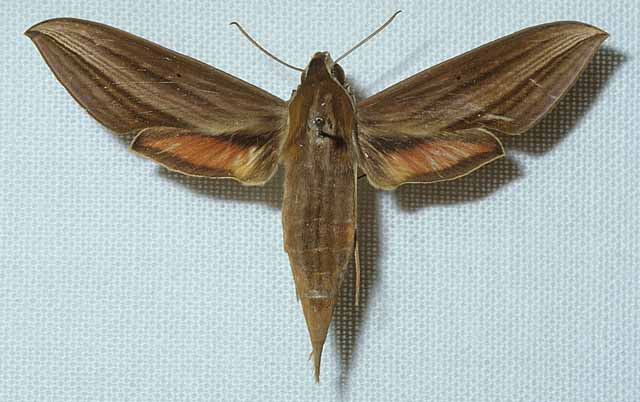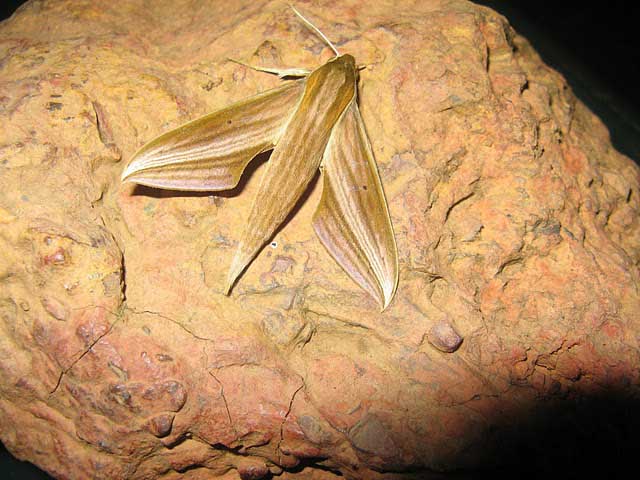|
|
Updated as per French Guiana Systematics (Sphingidae); May 7, 2011
Updated as per CATE (Venezuela, Brazil); May 7, 2011
Updated as per personal communication with Andres Urbas (Camp Caiman, near Kaw, French Guiana, April 29, 2011); May 7, 2011
Updated as per French Guiana Systematics: Sphingidae; May 18, 2011
|
Xylophanes neoptolemus
zail-AH-fan-eesmm
NEE-op-TOL-ih-mus
(Cramer, 1782) Sphinx

Xylophanes neoptolemus ?? male, courtesy of Hubert Mayer
copyright.
This site has been created by
Bill Oehlke at oehlkew@islandtelecom.com
Comments, suggestions and/or additional information are welcomed by Bill.
TAXONOMY:
Family: Sphingidae, Latreille, 1802
Subfamily: Macroglossinae, Harris, 1839
Tribe: Macroglossini, Harris, 1839
Genus: Xylophanes Hubner [1819] ...........
Species: neoptolemus (Cramer, 1782)
|
MIDI MUSIC
.....It's a Wonderful World.....
copyright C. Odenkirk
ON.OFF
<bgsound src="world.mid" LOOP=FOREVER>
|
DISTRIBUTION:
Those moths previously designated as Xylophanes neoptolemus have been divided, based on DNA barcoding results, into three species:
Neoptolemus balcazari flies in Guerrero, Mexico, and possibly into Belize.
Neoptolemus cthulhu flies in Guatemala and south to Costa Rica, and probably throughout most of Central America.
The true Xylophanes neoptolemus moths (approximate wingspan: males: 65-72mm; females: 73-82mm)
fly from
Trinidad, Suriname and
French Guiana: Kaw; Regina; Saint-Georges de l'Oyaok; to
Venezuela: Santa Barba; Caracas;
(Suriname is given as the specimen type locality.).
They are also recorded in much of
northwestern Brazil and are probably present in much of South America.
Chaerocampa trilineata Walker, 1864, Venezuela, is the same as Xylophanes neoptolemus neoptolemus.

Xylophanes neoptolemus, Camp Caiman, near Kaw, French Guiana,
April 29, 2011, courtesy of Andres Urbas, tentative id by Bill Oehlke.
I favour neoptolemus over loelia for the above moth for the following reasons:
1) strong presence of orange on the tegulae;
2) distinct and wide abdominal lines;
3) pinkish tinge on the forewings;
4) stronger contrasting areas on forewing.
I do not know how consistent those characters are. The specimen might be loelia. Complete view of lower wings or undersides would aid with determination.
This moth is also quite similar to Xylophanes loelia and Xylophanes libya but differs from both by the deeper red coloration of the median band of the
hindwing upperside. The mesothorax and metathorax have a pale grey medial band that continues onto the abdomen as a pair of thin lines, enclosing a darker
olive-green or brown median line. These three lines more distinct than in Xylophanes loelia and Xylophanes libya, and
the underside of wings is more red than in those two species.
The first fw postmedian line is narrow and continuous from inner margin to apex, a little less oblique than in
Xylophanes loelia, but more so than in Xylophanes libya.
The fourth postmedian line is also narrow and continuous (not formed from as series of vein dots as in Xylophanes libya and
Xylophanes loelia). The region between the first and fourth postmedian lines is distinctly yellow, contrasting with the pinkish coloration of the rest of the wing.
The black subapical dot is usually very small. The submarginal lines form a sharp angle anterior to M3 (as in Xylophanes libya).
The hw upperside median band is bright red, broader than in Xylophanes loelia and Xylophanes libya,
tapering towards and reaching, or almost reaching, the costa. The outer margin of the median band is convex and more distinct than in
Xylophanes loelia.
The ventral hw am and pm bands are continuous (as in Xylophanes loelia). The marginal band is not interrupted, but is dentate between M2 and M3.
There is no marginal spot between Sc+R and Rs. CATE.
FLIGHT TIMES:
Xylophanes neoptolemus adults probably fly all year throughout their range.
In French Guiana reports exist for January-February, April, November.
ECLOSION:
Pupae probably wiggle to surface from subterranean chambers or leaf litter just prior to
eclosion.
SCENTING AND MATING:
Females call in the males with a pheromone released from a gland at the tip of the
abdomen.
Use your browser "Back" button to return to the previous page.
Goto Main Sphingidae Index
Goto Macroglossini Tribe
Goto Central American Indices
Goto Carribean Islands
Goto South American Indices
Goto U.S.A. tables
The pronunciation of scientific names is
troublesome for many. The "suggestion" at the top of the page is
merely a suggestion. It is based on commonly
accepted English pronunciation of Greek names and/or some
fairly well accepted "rules" for latinized scientific names.
The suggested pronunciations, on this page and on other pages,
are primarily put forward to assist those who hear with internal
ears as they read.
There are many collectors from different countries whose
intonations and accents would be different.
Jean Marie Cadiou writes, "When I say "Xylophanes" in English I
pronounce it something like "Zailophanees", with the emphasis on the
"o". The French pronounce it differently, something like
"Kzeelophaness" with no emphasis, and the Germans yet in a
different way..."
"Xylophanes" sounds like it is from Greek mythology.
The species name, "Neoptolemus" is from Greek mythology.
Neoptolemus, also called Pyrrhus, was the only son of Achilles and
grandson of Peleus. Neoptolemus was a young, cruel and ferocious
warrior who later became king of Epirus and was finally
murdered in Apollo's temple at Delphi.
Use your browser "Back" button to return to the previous page.
This page is brought to you by
Bill Oehlke and the
WLSS. Pages are on space rented from Bizland. If you would like
to become a "Patron of the Sphingidae Site", contact Bill.
Please send sightings/images to Bill. I will do my best to respond to
requests for identification help.
Enjoy one of nature's wonderments: Live
Saturniidae (Giant Silkmoth) cocoons.
 | 
Show appreciation for this site by clicking on flashing butterfly to the left.
The link will take you to a page with links to many insect sites. |

Xylophanes neoptolemus male, Kaw, French Guiana,
on my home computer only.

Xylophanes neoptolemus female, SGO-Regina, French Guiana,
on my home computer only.





